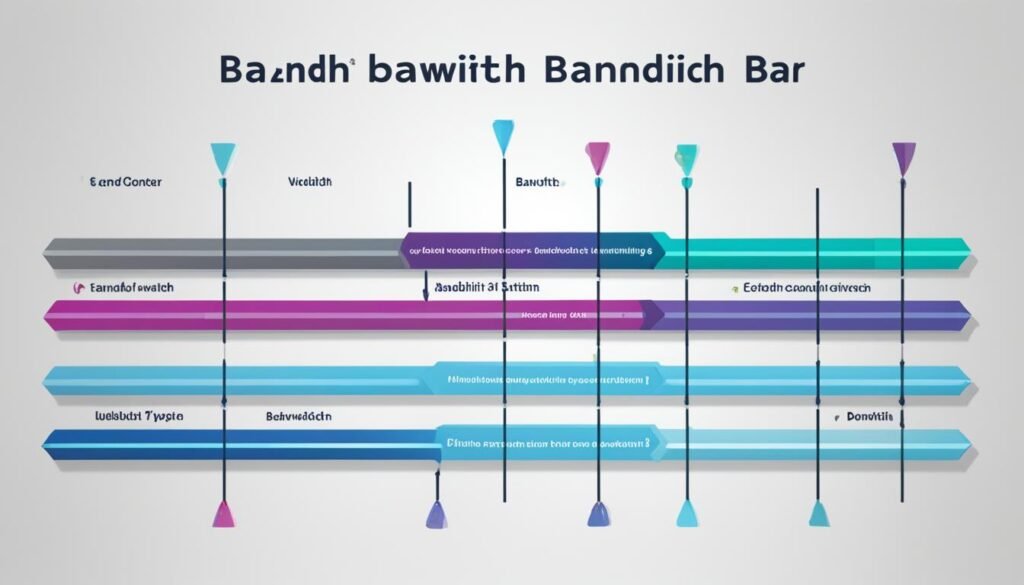Bandwidth is key in web hosting. It shows the max data that an internet connection can send. This is vital for quick website speeds. Understanding bandwidth is key. It tells how fast a site can show info to users.
More bandwidth enables faster loading times and better features. It also makes sites handle more users at once. Figuring out the right bandwidth for a website needs many details. This includes the size of the site, how many visitors you expect, and your site’s downloadable stuff. You can make your site’s bandwidth use smarter with tricks like image shrinkage and caching. This makes visitors’ time on your site smoother.
But, if you use more bandwidth than your plan allows, you might have to pay extra or your site could stop working for a bit. That’s why bandwidth is a big deal when picking a web hosting service. Finding the best fit between your site needs and what your host can give matters a lot. It keeps your site quick, available, and not too expensive.
Key Takeaways:
- Bandwidth is the maximum data transfer capacity of an internet connection, crucial for web hosting and website performance.
- Higher bandwidth enables faster loading times, more dynamic features, and the ability to handle increased traffic and concurrent visitors.
- Calculating the appropriate bandwidth requirements for a website involves considering factors like page weight, traffic volume, and downloadable content.
- Optimizing bandwidth usage through techniques like image compression and caching can improve the user experience.
- Exceeding a hosting plan’s bandwidth limit can result in additional fees or temporary site suspension, making bandwidth a key consideration when selecting a web hosting provider.
Understanding Bandwidth in Web Hosting
Bandwidth in web hosting is like a highway for data. It’s the amount of data that can move between a website and its visitors within a set time, measured in bits or megabits per second. This data transfer capacity decides how fast a website can show things like photos and videos to users. More bandwidth means website load times are quicker and works better overall. A good amount of bandwidth is vital for a website to be fast and work well, making visitors happy and keeping them coming back.
Definition of Bandwidth
In web hosting, bandwidth is the top limit of data an internet connection can send or receive. It showcases how much information a website or server can handle in bits or megabits per second. This way, everyone using the site understands the speed it can work at.
Bandwidth as a Data Transfer Capacity
The data transfer capacity that a website’s bandwidth offers shows how quickly it can share information with users. With more bandwidth, websites can send big files like videos and images faster. This leads to smoother user experiences and less time spent waiting for things to load.
Role of Bandwidth in Website Speed and Performance
Bandwidth in web hosting greatly impacts how fast a website can be and how it performs. Sites with more bandwidth can support lots of users at once and show their content quickly. This makes the user experience better and decreases the chance of people leaving because the site is slow.
Bandwidth vs. Data Transfer Rate
Bandwidth and data transfer rate are interconnected concepts, but they have distinct meanings. Bandwidth shows the maximum capacity of a connection to carry data. Data transfer rate, on the other hand, is the speed data moves in real time.
Think of bandwidth as a pipe size affecting the max data it can hold. The data transfer rate is the water flow speed in that pipe right now. Bandwidth is usually shown in bits or megabits per second. Data transfer rate uses bytes or megabytes per second.
Distinguishing Bandwidth from Data Transfer Rate
Knowing the difference between bandwidth and data transfer rate is key for website operations. Bandwidth shows how much data a site can handle. Data transfer rate measures the speed it actually moves at times.
In cases like high-traffic times or heavy content, the moving speed might be slower. Even good-sized pipes can slow down this way. On the other hand, with smart content design, even small pipes can manage well if they don’t get too crowded.
Measuring Bandwidth and Data Transfer Rate
Understanding bandwidth and data transfer rate is crucial for website performance checks. Hosts usually measure bandwidth, and it can also be checked online. The site’s data transfer rate can be watched via the host’s tools or other services.
Keeping an eye on both measures regularly helps site owners optimize their hosting and content. It ensures websites run smoothly and offer a great user experience.
Types of Bandwidth

When you think of web hosting, there are two key bandwidth types: server and website. It’s important to know the difference. This helps make sure your website runs smoothly and doesn’t cost too much.
Server Bandwidth
Server bandwidth is how much data the server can handle at once. It’s crucial for delivering a good user experience. The amount is set by your web host. It’s part of what you pay for.
Choosing a host with enough server bandwidth stops slow-downs. This way, your site will always be fast and responsive.
Website Bandwidth
On the flip side, website bandwidth is about how much data flows from your site to users. It depends on your site’s size and content. This, you can control by optimizing your site’s content and size.
By managing your site’s content wisely, you can keep your costs down. This ensures your hosting solution is efficient.
Having enough bandwidth is key for a great website. By knowing about these types of bandwidth, you can make smart choices. This helps your website grow and keeps users happy.
Bandwidth in Internet Connections

Bandwidth is crucial for internet speed, especially in broadband. Broadband is quick internet that lets you quickly access web pages, stream media, and download content. The bandwidth of a connection directly affects the speed users experience.
Broadband Internet Connections
Smoother connections, like fiber-optic or fast cable, move more data each second. This means quicker download and upload speeds. Broadband internet is key for enjoying all kinds of online content, from videos to cloud apps.
Bandwidth and Internet Speed
Choosing a good internet service provider and plan depends on bandwidth. It impacts how easily you can use the internet. Having enough bandwidth in internet connections is vital for a fast, smooth online experience. This includes web browsing, downloading, video calls, and gaming.
Bandwidth for Streaming Services and Online Gaming
For streaming services and gaming online, bandwidth is key for smooth operations. Streaming videos need a lot of bandwidth for streaming services to play without stopping. What’s needed changes with the video’s resolution, frame rate, and bitrate. Viewing 4K videos could need 15-25 Mbps of bandwidth.
Bandwidth Requirements for Streaming Video
To stream without issues, several things affect the amount of bandwidth for streaming services you need. Higher resolutions, like 4K or 1080p, need more bandwidth requirements for streaming to stay clear and buffer-free. The video’s bitrate, affecting how compressed it is, also affects bandwidth considerations for gaming. Premium video streams with high bitrates need more bandwidth for top-notch watching.
Bandwidth Considerations for Online Gaming
Gaming online also needs lots of bandwidth for online gaming for quick and fun gameplay. Enough bandwidth helps keep lags low and lets players interact smoothly and in real time. The game’s type, the player count, and extra features like voice chat all play into how much understanding bandwidth in streaming and gaming is needed for a good gaming session.
Making sure you have enough bandwidth for streaming services and bandwidth for online gaming is vital for user satisfaction. With knowledge of bandwidth requirements for streaming and bandwidth considerations for gaming, both hosts and users can plan better. This ensures their networks run smoothly for both streaming and gaming.
Bandwidth Management and Optimization

Keeping bandwidth management and optimization in check is key. It ensures your website runs well without high costs. Bandwidth throttling limits how much data users can use. This is done based on who they are, when they visit, or what they look at. It helps keep bandwidth usage steady.
To use bandwidth well, many strategies are in play. These include making media files smaller, using caches, employing CDNs, and loading images only when needed. These steps make a website faster by using bandwidth efficiently.
Bandwidth Throttling and Allocation
Bandwidth throttling gives website owners control. They manage how data is used, considering who the users are or when they log on. This taps into avoiding bandwidth overages. It helps keep the experience good despite heavy usage times.
Techniques for Optimizing Bandwidth Usage
Keeping bandwidth usage low means applying smart tactics. Doing this cuts the data moving but not the website’s quality. Key methods include:
- Compressing media files: Making images and videos smaller saves bandwidth without changing quality.
- Implementing caching mechanisms: Storing static content saves downloading time, and therefore, bandwidth.
- Utilizing content delivery networks (CDNs): With CDNs, content comes from closer servers, using less bandwidth but loading faster.
- Leveraging lazy loading: Not loading everything at once cuts down bandwidth use by loading on demand.
Using these methods ensures bandwidth is efficient. This makes the site load faster and improves user experience. Plus, it can save on costs.
Bandwidth Pricing and Costs

Prices for bandwidth can differ a lot. This is based on the provider and the model you pick. Examples of these are metered billing and tiered plans.
Bandwidth Pricing Models
With metered billing, you pay based on how much data you use. This is good because you can adjust your usage as needed. On the other hand, tiered plans come with a set price for a certain amount of data. This means you might have to pay extra if you go over the plan’s limit.
Factors Affecting Bandwidth Costs
Many things can change how much you pay for bandwidth. This includes how much data you use, the type of connection you have, where your server is, and any extra fees. Knowing about these costs and your exact needs can help you avoid surprise bills.
Bandwidth and Network Infrastructure
Bandwidth is key in making network infrastructures work well. This is true for places like data centers and cloud computing spaces. In data centers, it’s important for handling large amounts of data moving between servers and clients. For cloud computing, strong bandwidth is needed to smoothly give resources and services to users.
Role of Bandwidth in Data Centers and Cloud Computing
Today’s digital setups, including data centers and cloud services, need a lot of bandwidth. It’s needed to keep up with the increase in business and user needs. With enough bandwidth in data centers, data moves quickly between servers, storage, and devices. This helps with high-speed computing and easy access to apps and services online.
Bandwidth in Wired and Wireless Networks
In both wired and wireless networks, bandwidth is crucial. Wired networks, like Ethernet or fiber-optics, usually have more bandwidth than wireless ones. This disparity occurs due to issues such as how far away you are, things that might block the signal, and device limits. Knowing the needs and limits of bandwidth in different network types is vital for making systems that work well.
Bandwidth
Figuring out how much bandwidth you need for a website involves some careful thinking. You have to consider the size of each page and how many people will visit. Also, think about any stuff people can download from the site. By doing some math with these numbers, you can come up with a good guess for the necessary bandwidth.
Calculating Bandwidth Requirements
To find out how much bandwidth you need, look at the size of your web pages and guess how many visitors you’ll get each month. Also, consider any extra media or downloads for users. This info helps you figure out how much data will be used. Knowing this helps pick the right hosting plan with enough bandwidth for your site.
Monitoring and Measuring Bandwidth Usage
It’s key to keep an eye on your bandwidth use. You can use your host’s tools or other software for this. If you use up your bandwidth limit, you might have to pay more or face issues with your site. By watching how much bandwidth you use, you’ll know when it’s time to change your hosting plan to get the best performance and cost.
Also Read: How To Choose The Right Cloud Hosting Provider
Conclusion
Bandwidth plays a big part in web hosting. It decides how fast a website runs. With enough bandwidth, a website loads quickly. This lets visitors enjoy the site without delays or problems.
It’s key to know how much bandwidth your site needs. Then, pick a hosting plan that fits. This way, your site will be fast, easy to grow, and doesn’t cost too much.
Overall, bandwidth is vital for a website’s success. Those who focus on using their bandwidth wisely create better experiences for visitors. This approach is key for anyone serious about their online presence.
FAQs
What is bandwidth and why is it important for web hosting?
Bandwidth is the level of data a connection can transfer. It’s vital for web hosting because it affects a website’s speed. More bandwidth means faster loading and the ability to handle more visitors at once.
How is bandwidth defined in web hosting?
In web hosting, bandwidth is the data amount moving from a site to its visitors in a set time. It’s usually seen as bits per second or Mbps. This shows how much data can flow through an internet connection.
What is the difference between bandwidth and data transfer rate?
Bandwidth sets the limit on data flow capacity. Data transfer rate shows the actual data flow speed. It’s like the comparison between the size of a pipe and the water flowing through it.
What are the different types of bandwidth in web hosting?
Web hosting has server bandwidth and website bandwidth. Server bandwidth is the server’s data transfer capacity. Website bandwidth is the data a website sends to users in a certain period.
How does bandwidth affect internet connections and performance?
Broadband speed is directly tied to bandwidth. More bandwidth, like with fiber-optic, means faster internet. Users get quicker downloads and uploads with higher bandwidth.
What are the bandwidth requirements for streaming services and online gaming?
Streaming video needs a lot of bandwidth for smooth, quality playback. For 4K, you need at least 15-25 Mbps. Online games also need good bandwidth for low lag and quick reactions.
How can bandwidth be managed and optimized?
Bandwidth can be controlled through throttling. This is when it’s limited based on user, time, or content. To optimize, you can compress files, use CDNs, and implement lazy loading for images.
How does the pricing and cost of bandwidth vary?
The cost of bandwidth changes with the hosting provider and the plan type, like metered or tiered. It also depends on data volume, connection type, server location, and extra fees.
How does bandwidth impact network infrastructure and cloud computing?
To handle data in data centers and the cloud, enough bandwidth is key. Knowing the needs and capabilities of network structures is important. This ensures systems work well.
How can the appropriate bandwidth requirements for a website be determined?
Figuring out needed bandwidth means looking at page size, expected visits, and download content. Also, keep an eye on bandwidth use to ensure it’s right for your site.




